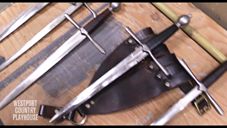The following article from 1934 details the evolution of a props director in film which was occurring throughout the twentieth century:
By Frank S. Nugent
It’s a far cry—in fact, it’s a good resounding whoop—from the humble, janitor-like property man of yesteryear to the high-geared, big executive who has the same title in the modern motion-picture studio. By way of illustration, one could point to Albert C. (“Whitey”) Wilson, head of the Warner studio’s property department, who was in town last week taking a turn through the local shops and shoppes, picking up some new ideas on decoration and making a few judicious purchases to “sweeten up the stock” on the Brothers’ ample shelves back in Hollywood.
Mr. Wilson is the purchaser and custodian of a property stock valued at $500,000. It fills one warehouse in the Burbank studios, five lesser storerooms elsewhere in Hollywood and another at the Sunset plant. Mr. Wilson has no idea just how many articles are on hand; somewhere in the “hundreds of thousands” was his best estimate. They range in size from a jeweled snuff box to a coach for Madame DuBarry or an English poster bed, Tudor style.
On twenty-four hours’ notice—and that generally is the best they can expect—his department can turn four studio walls into a penthouse gambling den or a fisherman’s chapel, the inside of a submarine or the outside of an airliner, a prison mess hall or a ballroom at a débutante’s coming-out party. Things like that are just routine and have no terrors.
But it’s a different story when Busby Berkeley comes along with his “Gold-Diggers of 1935” and asks, as he just did, for fifty ivory-hued grand pianos that do not, of necessity, have to play, but must be able to dance. Or when, as in “Wonder Bar,” the director insists upon a scene with twelve mirrors, each of which must be twenty feet high and sixteen feet long. Or when, as in “It’s Tough to Be Famous,” the Navy Department refuses, at the last minute, to lend the studio twenty-five submarine escape “lungs” and the property man is told to have prop imitations ready by 9 the next morning—and has to drive all over town at midnight looking for baking powder cans of a certain size because they happen to look like one important part of the “lungs.”
Things like that are what wear a man down, Mr. Wilson says. Oh, yes! He got the pianos for Mr. Berkeley; had them made up by one of the country’s largest piano companies. They’ll be seen waltzing around and going through formations in the next “Gold Diggers.” And he got the mirrors for “Wonder Bar.” They’re still in the studio warehouse, and once in a while he has a chance to use one of them—but not all, not ever again, he’s afraid.
Nugent, Frank S. “Property Man: New Style.â€Â New York Times, 25 Nov. 1934.



